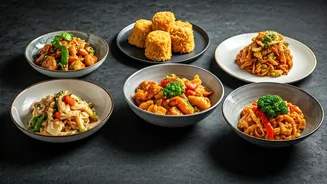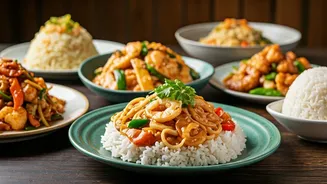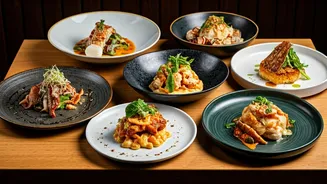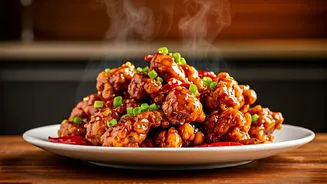Chop Suey’s Beginnings
Chop Suey, a mixed dish of stir-fried meats and vegetables in a thick sauce, is a classic. Many people believe it originated in the United States during
the late 19th century, driven by a culinary need for cheap food, where Chinese immigrants adapted local ingredients to create this dish. The exact tale varies, but one popular story suggests it emerged from a restaurant trying to satisfy a hungry customer with whatever ingredients were available. Chop Suey's popularity grew quickly, and it became a staple in American Chinese restaurants, though it never quite took root in China itself. It's a great example of how food travels and evolves, reflecting the unique cultures and availability of ingredients in the locations where it appears. This dish highlights the creativity of early Chinese immigrants as they adapted their culinary traditions in a new land.
The Rise of Fortune
Fortune cookies, with their sweet taste and cryptic messages, are another surprise. Their origins are not in China, but in Japan and the United States. Though not a Chinese creation, these cookies became a beloved part of the Chinese restaurant experience, and quickly took hold in the United States. The cookies are now a classic example of cultural adaptation and the way businesses adopted specific practices that worked for a specific culture. The messages within the cookies offer a glimpse into the diverse desires for knowledge or for a little optimism. The phenomenon demonstrates how cultures adopt and reimagine traditional practices to create new, delightful experiences.
Orange Chicken Origins
Orange Chicken, known for its sweet, tangy sauce and crispy fried chicken, is another dish that has deep roots in American-Chinese restaurants. It was developed in the United States and has become a favorite in the world. The dish showcases how Chinese chefs used the ingredients available in the country to provide the customer with a unique eating experience. Orange Chicken represents a fusion of flavors and the inventive spirit of chefs who adjusted to the requirements of the American palate. It has become a significant example of how global cuisines are created and adjusted depending on local preferences.
General Tso's Story
General Tso's Chicken is a sweet and spicy dish, a popular order in many restaurants. Despite its name and association with a Chinese military leader, the dish was created in Taiwan. It was later adapted and popularized in the United States. The story of General Tso's Chicken tells a story of the evolution of food, showing how chefs blend flavors to make them suitable to diverse palates. It is a symbol of the creative way in which dishes are changed, reflecting the constant process of cultural exchange.
Egg Rolls vs. China
Egg rolls, with their crispy, golden exterior and savory filling, are a common appetizer in many Chinese restaurants. But they are a distinct American creation, which is usually not served in China. They were created to satisfy American tastes and use local ingredients. They highlight how restaurants adapt their dishes to match the tastes of their audience, which demonstrates the changing nature of food in multicultural settings. The egg roll continues to be an example of cultural exchange and the way food styles change as they spread across the globe.
Sweet and Sour Tales
Sweet and Sour Pork, with its combination of crispy pork, colorful vegetables, and sweet and sour sauce, is a Chinese-American restaurant classic. While the dish has roots in China, the sweet and sour combinations found in Western restaurants developed in the United States to cater to local preferences. The dish's evolution reflects the cultural adaptation and ingenuity of chefs who have adapted dishes to reflect the tastes of new populations. It is a testament to the ever-evolving nature of food and the continuous process of cultural fusion.















